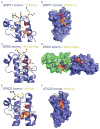Biological function and histone recognition of family IV bromodomain-containing proteins
- PMID: 28500727
- PMCID: PMC5683942
- DOI: 10.1002/jcp.26010
Biological function and histone recognition of family IV bromodomain-containing proteins
Abstract
Bromodomain proteins function as epigenetic readers that recognize acetylated histone tails to facilitate the transcription of target genes. There are approximately 60 known human bromodomains, which are divided into eight sub-families based on structural conservation. The bromodomain-containing proteins in family IV include seven members (BRPF1, BRPF2, BRPF3, BRD7, BRD9, ATAD2, and ATAD2b). The bromodomains of each of these proteins recognize and bind acetyllysine residues on histone tails protruding from the nucleosome. However, the histone marks recognized by each bromodomain protein can be very different. The BRPF1 subunit of the MOZ histone acetyltransferase (HAT) recognizes acetylated histones H2AK5ac, H4K12ac, H3K14ac, H4K8ac, and H4K5ac. While the bromodomain of BRD7, a member of the SWI/SNF complex, was shown to preferentially recognize acetylated histones H3K9ac, H3K14ac, H4K8ac, H4K12ac, and H4K16ac. The bromodomains of BRPF2 and BRPF3 have similar sequences, and function as part of the HBO1 HAT complex, but there is limited data on which histone ligands they bind. Similarly, there is little known about the histone targets of the BRD9 and ATAD2b bromodomain proteins. Interestingly, the ATAD2 bromodomain was recently shown to preferentially bind to the di-acetylated H4K5acK12ac mark found in newly synthesized histones following DNA replication. However, despite the physiological importance of the family IV bromodomains, little is known about how they function at the molecular or atomic level. In this review, we summarize our understanding of how family IV bromodomains recognize and select for acetyllysine marks and discuss the importance of acetylated histone recognition for their biological functions.
Keywords: acetyllysine; bromodomain; chromatin reader domain; epigenetics; histone.
© 2017 Wiley Periodicals, Inc.
Conflict of interest statement
The authors have no conflict of interest to declare.
References
-
- Aasland R, Gibson TJ, Stewart AF. The PHD finger: implications for chromatin-mediated transcriptional regulation. Trends Biochem Sci. 1995;20(2):56–59. - PubMed
-
- Avvakumov N, Cote J. The MYST family of histone acetyltransferases and their intimate links to cancer. Oncogene. 2007;26(37):5395–5407. - PubMed
-
- Bamborough P, Barnett HA, Becher I, Bird MJ, Chung CW, Craggs PD, Demont EH, Diallo H, Fallon DJ, Gordon LJ, Grandi P, Hobbs CI, Hooper-Greenhill E, Jones EJ, Law RP, Le Gall A, Lugo D, Michon AM, Mitchell DJ, Prinjha RK, Sheppard RJ, Watson AJ, Watson RJ. GSK6853, a Chemical Probe for Inhibition of the BRPF1 Bromodomain. ACS medicinal chemistry letters. 2016a;7(6):552–557. - PMC - PubMed
-
- Bamborough P, Chung CW, Demont EH, Furze RC, Bannister AJ, Che KH, Diallo H, Douault C, Grandi P, Kouzarides T, Michon AM, Mitchell DJ, Prinjha RK, Rau C, Robson S, Sheppard RJ, Upton R, Watson RJ. A Chemical Probe for the ATAD2 Bromodomain. Angewandte Chemie. 2016b;55(38):11382–11386. - PMC - PubMed
Publication types
MeSH terms
Substances
Grants and funding
LinkOut - more resources
Full Text Sources
Other Literature Sources
Research Materials



